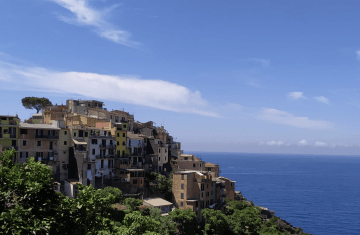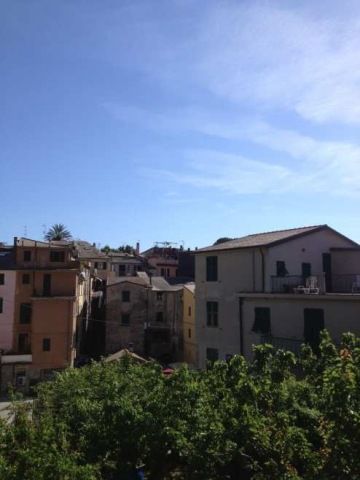
Yes, the village of Corniglia is just different. It’s perched on a steep hill and inaccessible, and from the sea, it looks like a tiny wonderland.
It is the third village of Cinque Terre and the only one without docking for boats and Cinque Terre ferry, and probably this detail, far from harming the village, makes it even more precious and magical.
Its wine was then decanted for centuries, and you can read about it even in Boccaccio’s Decameron, who had the abbot of Cluny treat himself with it … ah, the Vernaccia di Corniglia.
History and what to visit there
Of Roman origin, as the name derives from Gens Cornelia, the family owning the region, during the Middle Ages underwent various domains until in 1254 Pope Innocent IV gave it to Nicolò Fieschi that passed it to the Republic of Genoa.
This makes the village more elegant than the other four, with architectural details such as the friezes of the stone portals and the Gothic sandstone arches and the low houses typical of Genoese domination villages fortress, that we can now only imagine from its rests.
Do not miss the church of San Pietro in pure Gothic-Ligurian style with its internal Baroque overlays and colorful stained glass windows. The building with gothic arches in black stone in the churchyard is considered part of the ancient Fieschi coaching.
Events
St. Peter is celebrated on June 29th with the traditional Mass followed by a procession starting from the church and getting to the super panoramic (!) The terrace of Santa Maria, where once was a church, collapsed in the sea in the XIX century.
The local Public Assistance is used to offer the traditional cake of Fieschi, a big cake made of biscuits, chocolate, and cream.
Other typical festival specialties are the rice cake, made with rice, cheese, and eggs, and the cien, traditionally stuffed vegetables. Dishes were once baked in communal ovens scattered around the village or in private houses, opening their kitchen to the neighborhood for the festival.
For the occasion, locals light up the main streets, the band plays, and the evening culminates with fireworks. Ah, in theory, the bathing season here begins the following to respect an old local saying…
Coming down from San Pietro is the Ciapà square, and from there, you enter the village’s narrow streets, lined with bars, wine, and souvenir shops till the main square, Largo Taragio.
Walking up the stairs on the back of the square, you reach the oratory of St. Catherine and from there to the ruins of the ancient tower overlooking Manarola. From Largo Taragio you can also walk down to the Marina.
Getting there
From Levanto, you can take the Cinque Terre Express train arriving at the Station in just over 10 minutes, but the village is a few steps higher up … :)
There are three options here: the beautiful and scenic brick staircase called ‘Lardarina,’ which comprises 33 flights and well 377 steps, or the street or even the minibus whose ticket is included in the Cinque Terre Card.
Our tips
Well, unless you do not want to hike at all, we heartily recommend you to walk there, taking advantage of the beautiful trails that connect it to Manarola on one side and Vernazza on the other.
The path from Manarola via Volastra is one of our favorites, with stunning views and an abundance of different walkways through vineyards, woods, and cliffs. Stunning, just like the blue trail to Vernazza, unforgettable, especially at sunset!
Also, do not miss the Cinque Terre Walking Park guided tours and hike arranged by the National Park!






